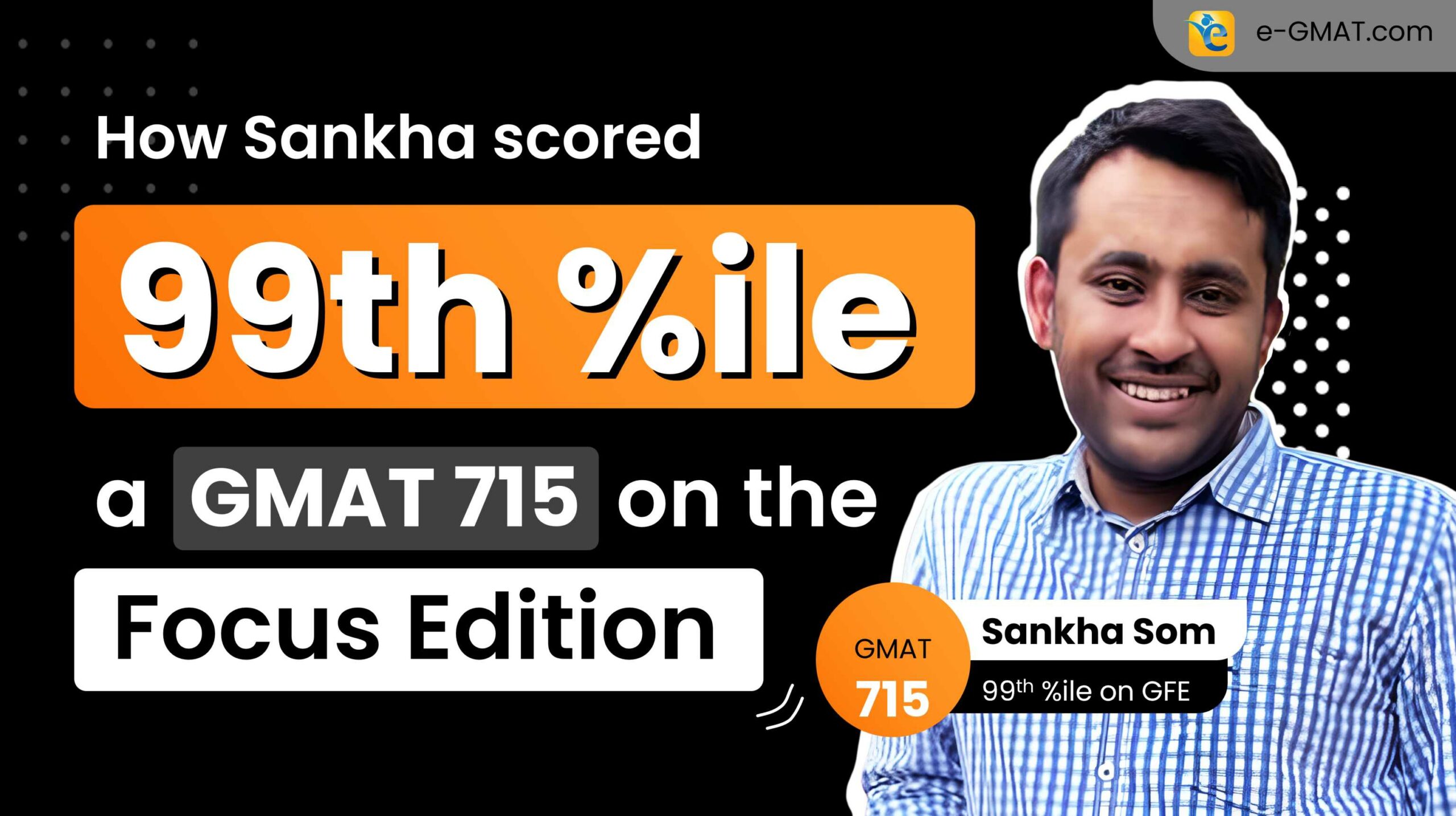For most GMAT aspirants, the journey to a top score is measured in months and occasionally years. But when Chetan, an electrical engineering student in Singapore, found himself pressed for time, he made a decision that would challenge conventional wisdom: compress his GMAT preparation into just 60 days. The result? A dramatic leap from 655 to a 99th percentile score of 715 in under 60 days.
- The Initial Challenge
- A Bold Strategy Shift
- Strategic Shifts in Preparation
- Targeted Learning Through Gap Analysis
- Leveraging Analytics for Improvement
- The Power of Customized Practice
- Data-driven insights enabled precise improvement strategies
- Real-Time Adaptation
- The Results of Strategic Focus
- The Power of Structured Support
- Conclusion
The Initial Challenge
Balancing the demands of an engineering program with GMAT preparation seemed impossible for Chetan. His first GMAT attempt after scattered preparation yielded a respectable but not ideal score of 655. With academic pressures mounting and limited time for a retake, he knew he had to change his approach.
“Managing something apart from college studies with the heavy workload this semester was not very easy,” Chetan reflects.
A Bold Strategy Shift
Chetan made a calculated gamble – he would concentrate his entire GMAT preparation into less than two months, from August 13th to his exam date on October 4th. This wasn’t just about studying harder; it was about studying smarter. The results speak for themselves:

This focused 60-day approach achieved better results than traditional 4-5 month preparation.
Chetan’s journey from 655 to 715 demonstrates that GMAT success isn’t about following conventional wisdom—it’s about finding an approach that works for your specific circumstances. His experience distils into three crucial insights:
• Concentrated Preparation Works: Two months of focused, integrated study proved more effective than four months of dispersed preparation. “Concentrating practice is the cherry on the cake,” as Chetan describes his process of improvement.
• Data Drives Better Decisions: Using analytics to guide practice and track progress transformed his preparation from guesswork to precision targeting.
• Support Structure Matters: Having a mentor provided not just guidance but the accountability needed to maintain momentum while balancing university studies.
It was this combination of structured support and data-driven insights that ultimately led Chetan to make a bold decision that would define his GMAT journey.
Strategic Shifts in Preparation
When most GMAT aspirants struggle with scores, the instinct is often to study longer. Chetan took the opposite approach, and his strategy offers valuable insights into effective GMAT preparation.

Rather than following a scattered approach, Chetan’s success demonstrates how the five key elements of GMAT preparation must work in harmony. His focused two-month strategy exemplifies this blueprint in action:
- Study Plan: Instead of stretching preparation over 4-5 months, Chetan concentrated his efforts into a focused two-month period. “Concentrating my prep actually helped me because those concepts are not going to get rusty,” he explains.
- Practice Tests: His mock test progression from 685 to 735 validated the effectiveness of his concentrated preparation approach. The systematic progression through mocks helped him understand the actual test environment and question patterns.
- Resource Utilization: Using e-GMAT’s Scholaranium platform, he could customize practice based on specific needs – from question type to difficulty level. “The question base is quite broad… I took multiple sectionals, multiple customized quizzes, cementing quizzes.”
- Time Management: His focused preparation allowed better time utilization, particularly evident in his test day performance where despite spending 7 minutes each on two challenging quant questions, he still managed to save 5 minutes overall.
- Stress Management: The systematic approach helped manage test day pressure. As he notes, “Even on the quant side, it wasn’t that I hadn’t seen those questions ever during my first attempt… it was just the test day stress that I couldn’t do it immediately.”
The blueprint proved effective – Chetan achieved a 60-point improvement (655 to 715) in less time than his previous attempt, demonstrating that structured, focused preparation trumps lengthy, unfocused study periods.
Targeted Learning Through Gap Analysis
Rather than attempting to master everything, Chetan’s approach focused on identifying and addressing specific weaknesses. “When I got the 655, I got two questions wrong on quant and both of them were number properties,” he recalls. This precise identification of gaps led to targeted improvements:
Quant Focus Areas
Rather than trying to master everything, Chetan focused on specific weaknesses in number properties and divisibility rules – topics that rarely appear in everyday mathematics. “That’s not something that you actually get to use in your daily math,” he notes. By addressing these fundamental gaps through e-GMAT’s portal, he built a comprehensive conceptual understanding that gave him confidence in his preparation.
Verbal Strategy Refinement
The key transformation in verbal came through better decision-making. “Earlier in CR, I used to narrow down to like two options and get the wrong option most of the times,” Chetan explains. Through systematic practice, he improved his pre-thinking approach and developed more reliable methods for eliminating wrong answers. This strategic shift helped reduce his verbal errors from eight to just four between attempts.
Data Interpretation Evolution
For DI, Chetan’s focus was primarily on execution rather than concept mastery. “It was mainly time management,” he notes, explaining how practice with proper DI questions helped him develop a more systematic approach. Using Scholaranium’s analytics, he compared his timing against median completion times, helping him calibrate his pace for optimal performance. This data-driven approach to timing proved crucial for maintaining accuracy under exam pressure.
Leveraging Analytics for Improvement
In today’s GMAT preparation landscape, having access to data isn’t enough – knowing how to leverage it makes the difference. Chetan’s success story demonstrates how strategic use of analytics can transform GMAT preparation from guesswork to precision targeting.
Understanding the power of data-driven preparation, Chetan made strategic use of analytics tools to transform his study approach. “The question pool is quite large,” he notes. “I could customize it exactly as per my needs.”
The Power of Customized Practice
Chetan’s approach to practice wasn’t just about solving questions; it was about creating a personally tailored learning environment. The real power of analytics came from how Chetan used this information to make strategic decisions. “Getting to know compared to others how I’m performing on the timing actually helped me know that you should be getting this question within this time frame,” he explains.
How did Chetan leverage Scholaranium?
This customization manifested in several key ways:
- Question Type Focus:
- Targeted drills for specific CR types (assumptions, inferences)
- Customized quizzes based on difficulty levels – medium and hard
- Sectional practice tests aligned with weak areas
- Performance Tracking:
- Median time comparisons with other test-takers
- Question-specific accuracy rates
- Option weightage analysis for better understanding

Key insights from analytics helped him:
- Optimize Timing:
- Identified questions taking excessive time
- Adjusted pacing strategies based on data
- Focus Practice Efforts:
- Targeted areas with below-median performance
- Validated strategy effectiveness through consistent tracking
This customization manifested in focused practice sessions, performance tracking, and real-time adaptations based on analytics insights. The platform provided crucial data about timing benchmarks, accuracy rates, and performance trends, allowing Chetan to make informed decisions about his preparation strategy.
Data-driven insights enabled precise improvement strategies
The analytics platform provided actionable insights beyond just numbers. Through detailed question analysis, Chetan could monitor the percentage of students choosing each option and time spent by successful test-takers. The platform’s cementing quiz performance metrics and skill development tracking helped identify areas needing additional focus.
Real-Time Adaptation
Perhaps most crucially, analytics enabled Chetan to adapt his preparation in real time. This insight helped him understand question difficulty progression and build realistic performance targets. The data showed him that scoring 5 or 6 out of 10 on hard practice sets wasn’t a sign of inadequate preparation but rather an indication of appropriate challenge level. This understanding proved crucial for maintaining confidence during preparation.
The real power of analytics came from how Chetan used this information to make strategic decisions.
“Getting to know compared to others how I’m performing on the timing actually helped me know that you should be getting this question within this time frame,” he explains.
The Results of Strategic Focus
The effectiveness of this approach became evident in his mock test progression

This consistent upward trend, achieved in just two months, demonstrated the power of concentrated, strategic preparation. Most notably, his verbal performance showed dramatic improvement, with errors reduced from eight to four questions. This strategic use of analytics transformed his preparation from a standardized approach to a personalized, data-driven journey toward GMAT success.
The benefits of this data-driven approach became evident during the actual GMAT. Despite spending seven minutes each on two challenging quant questions, Chetan’s analytics-informed preparation meant he could stay confident and manage his time effectively across sections. He completed the quant section with five minutes to spare, and his thorough understanding of timing benchmarks helped him maintain composure even when faced with unexpected challenges.
“I wasn’t expecting a Q90 because I was unsure about those two questions, but luckily I got all of them correct,” he reflects, demonstrating how data-driven preparation translated into test-day success.
The key insight from Chetan’s experience isn’t just about studying more – it’s about studying smarter. His approach proves that with proper strategy and focus, traditional preparation timelines can be challenged successfully.
The Power of Structured Support
While many GMAT aspirants focus solely on study materials and practice tests, Chetan’s journey highlights how structured support with e-GMAT’s Last Mile Push (LMP) Program can be the difference between good and exceptional results. His experience demonstrates that the right mentorship isn’t just about guidance—it’s about creating a framework for success.
The Mentor-Student Partnership
“I needed someone to rely on,” Chetan candidly shares. In the high-stakes environment of GMAT preparation, especially while juggling university studies, this support proved crucial. The partnership began with a simple but powerful premise: complete trust in the process.
What role did LMP play?
The mentorship structure provided several key advantages that proved instrumental to Chetan’s success:
- Quick Response System: With consistent, timely email responses, Chetan never faced momentum-killing delays in his preparation.
- Clear Accountability: Regular progress check-ins and detailed reporting requirements kept him on track despite his busy university schedule.
- Strategic Planning: His mentor, Rida helped chart out a focused study plan that maximized the limited two-month preparation window.

“Whatever she’s telling me to do, just do that and I should hopefully be getting that score,” Chetan reflects on his approach to mentorship with Rida, his mentor at e-GMAT. This trust was well-placed, built on a foundation of responsive support and proven strategies.
“Having someone pushing me was the only thing; otherwise, I wouldn’t have been able to do that.”
Strategic Test Preparation
The mentorship program’s impact was particularly evident in the mock test phase. Under his mentor’s guidance, Chetan followed a carefully structured progression that revealed both his growth and areas needing attention:
His mock test journey showed clear progression:

Chetan’s Mock Journey
This wasn’t merely about numbers. Each mock test served as a learning opportunity, with his mentor helping him to decode patterns, identify areas for improvement, and adjust strategies accordingly. The average score of 705 across these tests gave Chetan a realistic picture of his preparedness while maintaining his confidence for the actual exam.
The Final Stretch
In the crucial final weeks of preparation, mentorship proved its greatest worth through strategic interventions. One of the most significant decisions came in the form of section order optimization. “We switched from quant-verbal-DI to quant-DI-verbal,” Chetan explains. “That really helped me because DI has a mix of both… and then verbal is just a proper transition.”
This strategic shift, along with other mentor-guided adjustments, created several notable improvements:
- Optimized Time Management: Despite spending fourteen minutes on two challenging quant questions, Chetan recovered to save five minutes by the section’s end.
- Enhanced Section Transitions: The new order provided better mental flow between different question types.
- Increased Confidence: Understanding his performance patterns helped him maintain composure during challenging sections.
This combination of mentorship, strategic planning, and optimized section ordering proved crucial in Chetan’s final push to success. While his mentor provided the framework and accountability, it was the synthesis of all three elements – focused preparation, data-driven practice, and structured support – that ultimately led to his remarkable achievement.
Conclusion
Chetan’s journey from 655 to 715 in under 60 days demonstrates that GMAT success isn’t bound by conventional timelines or traditional approaches. By combining focused preparation, data-driven analytics, and structured mentorship, he achieved what many consider impossible – significant score improvement in less than half the typical preparation time. His experience proves that with the right strategy, tools, and support system, ambitious GMAT goals are achievable even under time constraints. The key lies not in how long you prepare but in how effectively you use the time you have. For future GMAT aspirants, Chetan’s success serves as a powerful reminder that challenging traditional preparation paradigms can lead to extraordinary results when backed by a structured approach and unwavering dedication.
Are you planning to pursue MBA at top business schools? Let us help you conquer the first step of the process i.e., taking the GMAT. Take a free mock test to understand your baseline score and start your GMAT prep with our free trial. We are the most reviewed online GMAT Prep company with 2000+ five star reviews on GMATClub.















